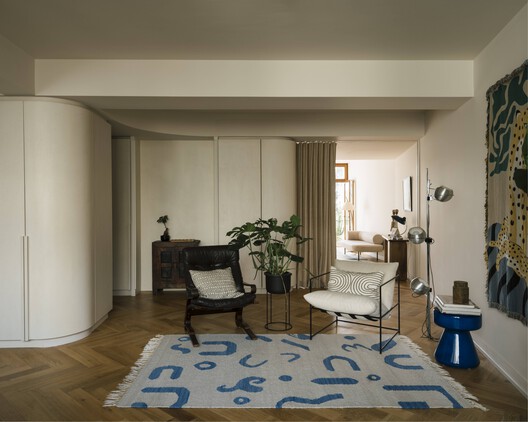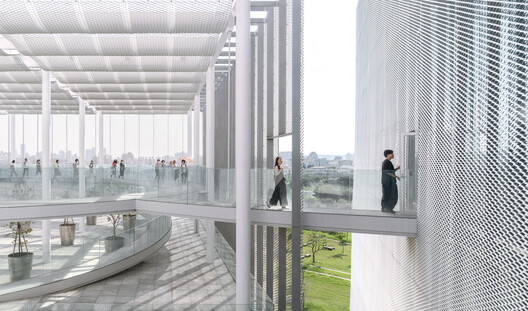Cob not just "a hobbit house" material says researcher developing modern version


Cob is a low-carbon material poised for a revival, according to scientist Steve Goodhew. In this Building with Cob interview, he explains how his invention, CobBauge, is guiding the way.
"Cob has the potential of being one of the mainstream material choices," Goodhew told Dezeen.
"All the science has been done – it's out there, you can do it," he said.
"The issue is more, in my view, how do you get that contemporaneousness to the material so it stops being seen as one for a hobbit house, and it starts being seen as something desirable?"
Cob is a type of unfired earth-based construction material made from clay-rich subsoil, mixed with fibrous material such as straw and water, and sometimes also sand or aggregate.
It has been used around the world for centuries, but fell out of favour during the Industrial Revolution when fired bricks became more accessible.
Today, cob is often perceived as bohemian, but a small group of innovators are now challenging this narrative to reposition the material as a viable alternative to brick and concrete.
CobBauge "unpicked the major technical barriers"
Among those innovators is Goodhew, a Plymouth University researcher and leader of the team behind CobBauge, which is a modern interpretation of the ancient material.
Aided by EU funding, the research team spans the UK and France and set out to find a way for cob to be commercially viable and meet contemporary building regulations concerning strength and insulation, in both countries.
Its name nods to these roots, formed from merging the material's French and English names.
For Goodhew, the primary reason for returning to cob as a construction material is that it's compostable, reusable and "ultra-low carbon".

"The material's ultra-low carbon in the way that not only do you use far less energy in its production, but you also would use far less energy in its destruction as well," he explained.
"Cob becomes compost, if you want it to. It comes from the earth, it goes to the earth."
However, to meet current regulations in the UK for insulation, a traditional cob wall would have to be over one metre thick. CobBauge helps keep wall thicknesses below that.
"The issues come down to how do you take this material and how do you widen its approach," Goodhew explained.
"One of the big barriers was, and probably still is, regulation," he explained. "What the CobBauge project's done is it's unpicked the major technical barriers and the training barriers to using it."
"I don't think people know that this is an option"
CobBauge is a composite wall comprising two grades of cob bonded together. A dense version is used for the outer wall, and a more lightweight version for insulation.
The dense version resembles traditional cob, while the insulating layer contains a high percentage of hemp shiv. Together, they form a solid monolithic structure that does not require secondary insulation.
Another feature of CobBauge is that it utilises a formwork. This is not required for traditional cob, which is built up in layers, without either formwork or framework.
The formwork comprises a metre-high timber frame lined with mesh, and a wooden box occupying the half of the wall where the insulating layer will go. This box is removed once the structural mix is in place.
The mesh and thinness of the walls help speed up the dry time – approximately a week and a half – before the formwork is raised and reused for further layers.
While CobBauge is helping pave the way for cob's comeback, Goodhew said awareness of the material now needs to be widened in order to encourage its uptake. To do this, precedents are needed to prove it can be a contemporary material, and not one just for "hobbit houses".

"There are clients who do want to build in cob, but they tend to be very well informed, and they tend to be fairly wealthy, and they're happy to spend on this," he explained.
"What it needs now is some exemplars to be able to show how good it actually is."
So far, only a handful of buildings have been created in CobBauge, including a teaching building for Plymouth University designed by Fox Eco Architecture and the first CobBauge house by Hudson Architects.
The CobBauge team is also currently writing a book on the system and has produced 32 YouTube videos on how to use the technique so it "is possible with any builder".
"Once you start and people know that this is actually an option, then they will pick it," said Goodhew. "I don't think people know that this is an option."
Retrofit and "flying factories" next on agenda
While CobBauge is primarily intended for new-build projects such as housing, Goodhew and his team are now exploring how the material can also be used in building preservation.
The team is working with Historic England to uncover ways to use the CobBauge system to upgrade the building fabric of historic properties "that are way behind many of the standards we'd like them to be at".
"The issue with historic buildings is often you do not use modern materials with them, like polymeric paints, or cementitious renders, because what it does is it traps moisture," Goodhew explained.
"Older buildings move, and a lot of the modern materials don't," he continued. "That causes cracking, which then causes delamination, which causes failure."
"So we're seriously looking at producing prototypes which you could use for old properties to upgrade the insulation value, using our light inner layer to improve the thermal insulation value, but not destroy the breathability of the building."
While Goodhew believes CobBauge is viable for contemporary construction, he is now exploring how to take it further.
His team is exploring the prospect of "flying factories" – temporary tent-like facilities used to produce cob components on or near a construction site to allow structures to be built in controlled conditions and facilitate faster on-site installation.
He is also working with Terran Robotics to explore how building with cob can be automated to speed up construction, improve build quality and minimise cost.
"Terran Robotics took this wonderful construction technique for building really high-end homes, automated it and is now making it the cheapest way to build," he said.
However, he clarifies that alongside these innovations, there remains a place for traditional cob self-builders who champion cob as a slow and community-driven construction method.
"I don't think there's an either or," Goodhew explained. "It's not just saying CobBauge is the only answer."
"The two sides of this construction decision come from two different places of what people want about their building," he continued.
"If you built your own with your own hands, there is something that person is getting from that process that you will lose if you are looking to take the material and trying to broaden its appeal."
The design collective Cella also touched on this theme in an interview with Dezeen, stating that innovations like CobBauge are needed if cob is to become mainstream again.
"Ideally, the world would slow down, and cob as a slow, meditative, community-driven construction method would return," they said.
"But in the meantime, it might be more effective to make innovations in the technique which make it more efficient, accessible and widely adopted."
Another researcher paving the way for cob to make its comeback is Tavs Jorgensen, who has developed a method of extruding cob into brick shapes to help make it more accessible.
The photography is courtesy of the CobBauge project unless stated otherwise.

Building with Cob
This article is part of Dezeen's Building with Cob series investigating modern uses of cob – an ancient building material made from clay-rich soil, straw and water – and exploring whether it can become a mainstream alternative to planet-damaging construction methods.
The post Cob not just "a hobbit house" material says researcher developing modern version appeared first on Dezeen.




















































